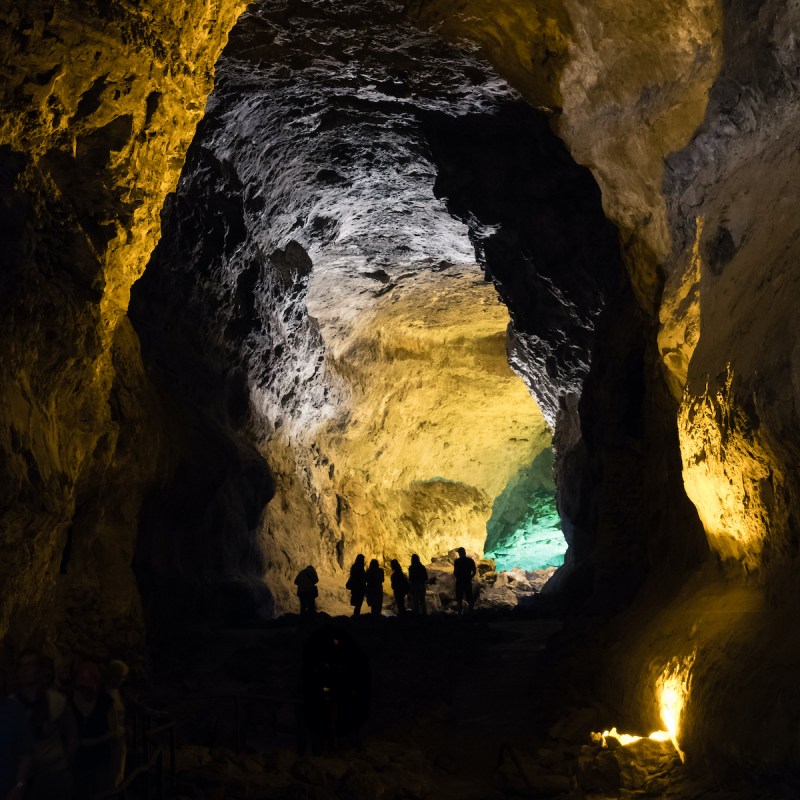
Spain is a country with many mountain ranges, from the Pyrenees in the north to the Sierra Nevada in the south, not to forget the mountains on the Balearic and Canary islands. And where there are mountains, there are caves, and Spain features some very spectacular ones.
Videos by TravelAwaits
Spain’s caves are — with a few exceptions — open to the public. They are awesome, but equally interesting are the stories of how some of them were discovered by chance. There are caves with prehistoric drawings, or with interior lakes you can take a boat trip on. Others are so vast that they are used as concert halls because the acoustics are so great.
For the moment, forget about the cliché image of sunshine and sandy beaches, flamenco and paella in Spain, and follow us on a fascinating voyage underground through Spain’s most famous caves.

1. Cave Of Altamira
Near Cantabria
The Cave of Altamira is located 19 miles west of the coastal city of Santander, in Cantabria, northern Spain. It contains Spain’s most important examples of prehistoric cave art and drawings. Estimated to be some 14,000 years old and discovered in 1868 by a local hunter, it took many years for the cave to be recognized by archaeologists and other scientists as the important find it really was.
The cave’s owner, Marcelino Saenz de Suatuola, began excavations of his cave’s floor in 1879. It was, however, his 7-year-old daughter Maria, who went further into the cave and … looked up! What she saw was the real discovery, a huge painting of a red bison (that she thought was a bull) outlined in black on the ceiling. This drawing is still the symbol of Altamira.
Finally, serious scientists took notice and discovered further drawings of equal quality in the walls and other halls. The cave is 885 feet long and was accessible only to scholars and scientists until 2002. Then a system was established by which 5 members of the public were chosen who could, dressed in biohazard suits, visit the cave once a week. All came to a halt with the outbreak of COVID, however; generally speaking, visits are not possible at the moment.
However, a museum and exact replica, known as Neocave has been created is open to the public again. Check the website info before you go.

2. Caves Of Nerja
Malaga
These caves are located near the coastal town of Nerja in Andalusia, southern Spain. Discovered in 1959 by a few local boys who were on a nigh walk hunting for bats, they are famous for their rock formations, although some prehistoric paintings and drawings have also been found.
Open to the public since 1960, the caves are divided into several halls, each named after the special form of stalactites and stalagmites found in them. The Hall of Waterfall (stalactites forming a rock waterfall) is the venue where the yearly International Festival of Music is held. The world’s largest stalactite graces another hall. All halls and caverns are connected by tunnels, bridges, and pathways with many steps in between. Be prepared to walk a lot and wear solid footwear if planning to visit the caves of Nerja.

3. Cuevas Del Drach
Mallorca
Mallorca, the largest of the Mediterranean’s Balearic Islands, is home to the awesome Cuevas del Drach, or Dragon Caves. Located near Manacor, the caves were already known in the Middle Ages and were further explored in 1880 and 1896, when the interior lake known as Lake Martell was discovered. The complex consists of four caves connected by water and is approximately three miles in length. The beauty lies in the rock formations inside the caves, like the Bath of Diana and the ceilings which are formed by needle-sharp stalactites. The tour lasts about one hour, and the highlight is a boat trip around the lake accompanied by a 10-minute classical concert and the magical lighting that illuminates water and rocks.

4. Cueva De Los Verdes
Lanzarote
The next cave adventure takes us truly underground. It’s to the lava tube of Cueva de los Verdes on the island of Lanzarote, one of the Canary Islands in the Atlantic Ocean.
The entire lava tube, which runs from the top of a volcano straight into the sea, is 3.72 miles. The walls of the tube are interspersed with 16 lava caves. One of them, known as the Cave of Atlantis, is even underwater.
The cave/tube is located within the Monumento Natural de La Corona, a nature reserve of the island. It is of volcanic origin, like just about everything on the island, and can only be explored by a one-hour guided tour. The volcanic history that led to its formation and will be explained during the tour. A lot of walking and climbing up and down is involved, so make sure to wear sturdy boots.

5. Cuevas Del Aguila
Ávila
The “Caves of the Eagle” are a mesmerizing underground world of stalactites, stalagmites, and columns, all made even more spectacular because they are all colored. This was caused by the abundance of minerals in the Paleozoic limestone that formed them and the water dripping down over millions of years. The cave is estimated to be between 500 and 540 million years old.
Located in central Spain on the border between Castile y León and Estremadura, the cave lies under a hill covered with dense oak forest. This accounts for the fact that it was only discovered in 1963. Again, kids have been the explorers; five of them that were playing on the hill suddenly noticed steam coming out of a hole in the ground. They squeezed through the narrow entrance and came upon the wonderful world of the Great Vault.
The caves are reached in approximately 1.5 hours driving south from the great medieval town of Avila, famous for the massive walls that encircle the entire city. Madrid is approximately the same distance away.
Since 1964, the cave has been open to the public. A guard at the entrance supervises safety measures and dispenses sanitary gel. Well-lighted paths with glass walls make for an easy visit of the about one-mile length of the cave. When visiting, be prepared for high humidity and some slippery stretches along your way. The steam the kids had seen came from the difference in temperature between inside the cave and the cold air outside.

6. Cueva Del Viento
Tenerife
If you are claustrophobic, skip this cave; otherwise, be prepared for a true adventure. You are entering Europe’s longest lava tube, the fifth largest of the world, only surpassed by those in Hawaii. The total length of the many passages is an impressive 10.5 miles.
Located in the village of Icod de los Vinos in the northeast of the Canary Island Tenerife, you best reach the tube from the capital, Santa Cruz. The tube was formed by lava flow from the volcano Pico Viejo, sitting alongside Mount Teide.
You can only visit via a tour that starts at the visitor center. From there, you are picked up by a vehicle and then have to continue on foot through farmland and pine forests to the entrance, where you are guided inside and explore for approximately 45 minutes. The entire tour lasts two hours. This is an adventure for the fairly fit.
Pro Tip: The floor of the tube is quite uneven; therefore, you must wear hiking boots or sturdy shoes. You are not allowed to stray into side passages or to touch anything. It’s obligatory to wear long trousers and the provided safety helmet at all times. If you get tired along the way, advise the guide immediately.

7. Cueva de Valporquero
Castilla Leon
Located close to the beautiful Gorge of Vegacervera in central Spain, this cave is the youngest of our cave collection, estimated to be “only” 1,000,000 years old. It was formed by the icy waters of the Valporquero river trickling slowly through the limestone and creating stalagmites, stalactites, and bizarre sculptures. The cave is divided into seven rooms, some of which have been named according to the shapes within, like Fairies or Tower of Pisa. Are you a fan of potholing? If so, here you are in the right place.
The nearest city is the capital, Leon, at a distance of 30 miles.
Further Reading:
